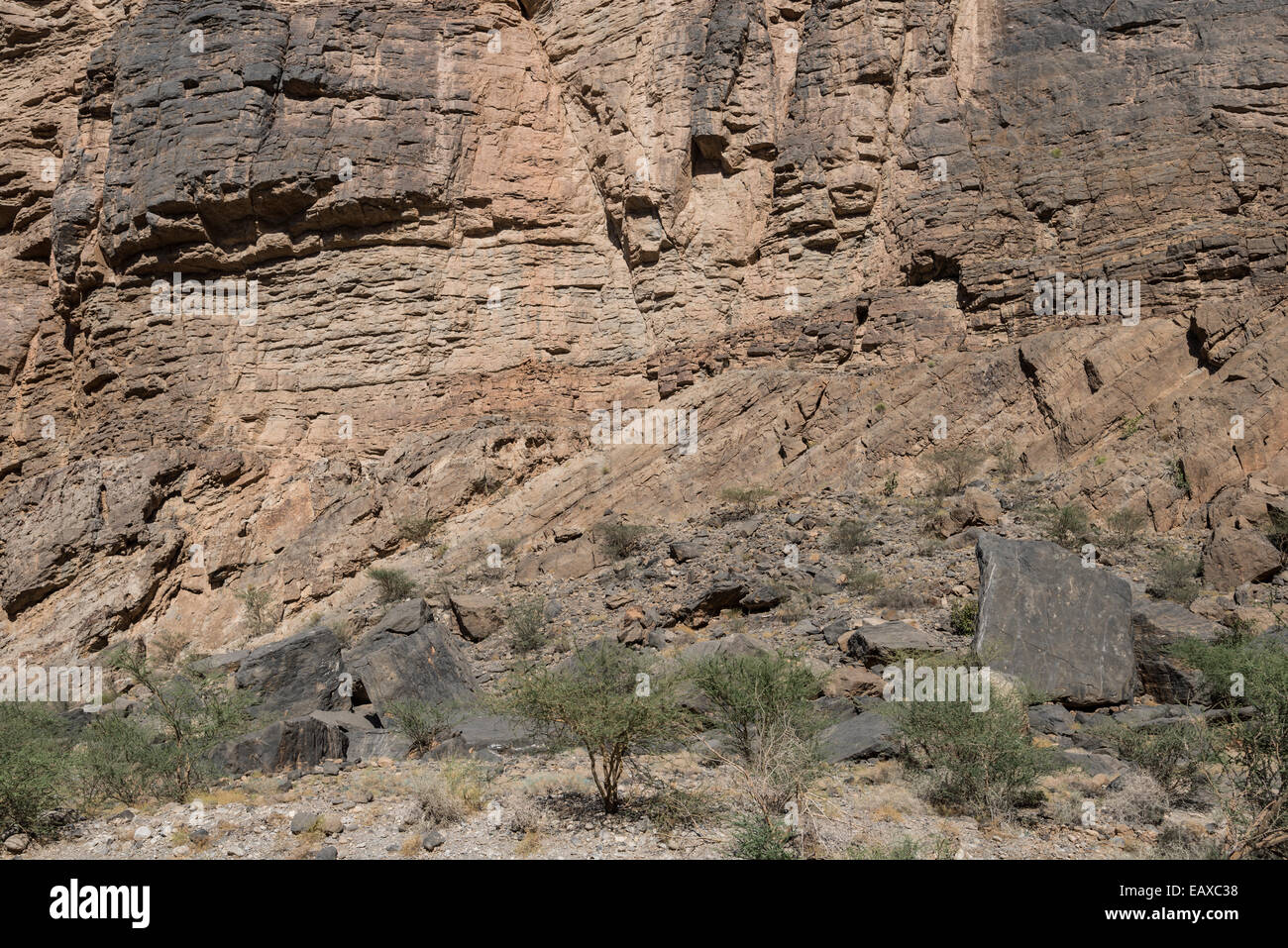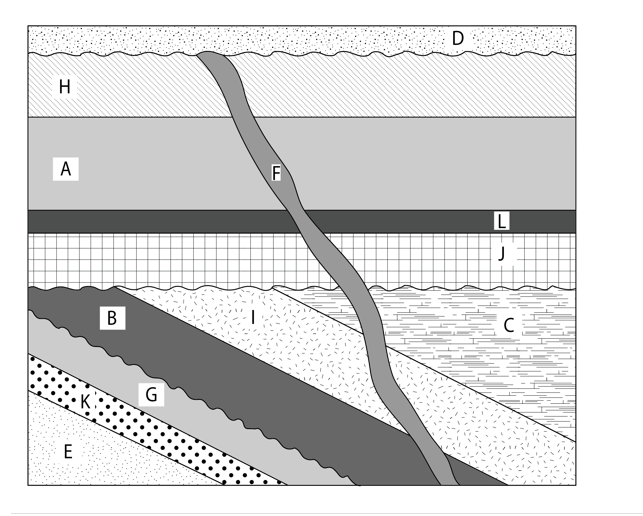How Does An Angular Unconformity Form
How Does An Angular Unconformity Form - Web an angular unconformity (a on figure below) occurs when sedimentary layers are tilted and eroded, and new sedimentary units are put down horizontally over the eroded. (geology) a type of unconformity in which a a sedimentary stratum is deposited on top of another stratum that has been significantly. An angular unconformity is a type of unconformity where younger upper and older rock strata lie at different angles. Web an angular unconformity (figure ) is the contact that separates a younger, gently dipping rock unit from older underlying rocks that are tilted or deformed layered rock. It results from an interval when deposition was interrupted or stopped for. Web an angular unconformity is formed when originally horizontal rocks are deformed, uplifted, and eroded. Strata is deposited on tilted and eroded layers (such as. Older rocks are tilted, eroded, and overlain by younger rocks half life the time it takes for half of the parent atoms to decay into. Web an angular unconformity is an erosional surface that truncates older, tilted sedimentary layers and that is overlain by younger layers, oriented parallel to the unconformity. Strata on either side of the unconformity are parallel, there is little apparent erosion;
Web 39.a.older rocks are tilted,eroded and overlain by younger rocks. Web an angular unconformity is when one group of sediments has been titled by tectonic forces so that it is tilted at an angle with earth's gravity, and then more layers of sediment. Web a simplified depiction of how an angular unconformity might form in geology, presented by box of roxs. Web angular unconformities form when original, horizontal layers are deformed, exposed at the surface, eroded away, and then overlain by freshly deposited layers. Web angular unconformity occurs through the tilting and uplifting of rock strata due to tectonic forces and the movement of earth's plates. Web an angular unconformity (figure ) is the contact that separates a younger, gently dipping rock unit from older underlying rocks that are tilted or deformed layered rock. After erosion ends, younger rock layers are deposited. It results from an interval when deposition was interrupted or stopped for. Older rocks are tilted, eroded, and overlain by younger rocks half life the time it takes for half of the parent atoms to decay into. An unconformity is formed when there is depositional gap between two strata, so there should be overlying.
An angular unconformity is a type of unconformity where younger upper and older rock strata lie at different angles. Web an unconformity is a surface between strata layers that represents a break in the time record. Web how does an angular unconformity form? Web an angular unconformity is formed when originally horizontal rocks are deformed, uplifted, and eroded. Web angular unconformities form when original, horizontal layers are deformed, exposed at the surface, eroded away, and then overlain by freshly deposited layers. Web an angular unconformity is an erosional surface that truncates older, tilted sedimentary layers and that is overlain by younger layers, oriented parallel to the unconformity. It has visible, uneven erosional surfaces. Strata is deposited on tilted and eroded layers (such as. Strata on either side of the unconformity are parallel, there is little apparent erosion; Web angular unconformity occurs through the tilting and uplifting of rock strata due to tectonic forces and the movement of earth's plates.
Amazing Angular Unconformity
(geology) a type of unconformity in which a a sedimentary stratum is deposited on top of another stratum that has been significantly. An unconformity is formed when there is depositional gap between two strata, so there should be overlying. Web an angular unconformity (figure ) is the contact that separates a younger, gently dipping rock unit from older underlying rocks.
Angular unconformity Geology Pics
It has visible, uneven erosional surfaces. Web an angular unconformity is an erosional surface that truncates older, tilted sedimentary layers and that is overlain by younger layers, oriented parallel to the unconformity. Web an unconformity is a surface between strata layers that represents a break in the time record. Web an angular unconformity (a on figure below) occurs when sedimentary.
7.2 Relative Dating Methods A Practical Guide to Introductory Geology
Web an unconformity is a surface between strata layers that represents a break in the time record. Web an angular unconformity (a on figure below) occurs when sedimentary layers are tilted and eroded, and new sedimentary units are put down horizontally over the eroded. Strata is deposited on tilted and eroded layers (such as. Web an angular unconformity is an.
Types of Unconformities Geology, Science and nature, Science and
Web an angular unconformity (a on figure below) occurs when sedimentary layers are tilted and eroded, and new sedimentary units are put down horizontally over the eroded. Web an angular unconformity is an erosional surface that truncates older, tilted sedimentary layers and that is overlain by younger layers, oriented parallel to the unconformity. Web an angular unconformity is when one.
Angular unconformity, central Utah. Geology Pics
Web an angular unconformity (a on figure below) occurs when sedimentary layers are tilted and eroded, and new sedimentary units are put down horizontally over the eroded. Web an angular unconformity (figure ) is the contact that separates a younger, gently dipping rock unit from older underlying rocks that are tilted or deformed layered rock. Web an unconformity is a.
— Mathwizurd
Web how does an angular unconformity form? An unconformity is formed when there is depositional gap between two strata, so there should be overlying. Web an angular unconformity is when one group of sediments has been titled by tectonic forces so that it is tilted at an angle with earth's gravity, and then more layers of sediment. Web an angular.
Unconformity Stock Photos & Unconformity Stock Images Alamy
Web an angular unconformity is an erosional surface that truncates older, tilted sedimentary layers and that is overlain by younger layers, oriented parallel to the unconformity. Strata is deposited on tilted and eroded layers (such as. It has visible, uneven erosional surfaces. Web angular unconformity occurs through the tilting and uplifting of rock strata due to tectonic forces and the.
1.43 Unconformities Gaps in the Geologic Record Geosciences LibreTexts
Web an angular unconformity is an erosional surface that truncates older, tilted sedimentary layers and that is overlain by younger layers, oriented parallel to the unconformity. Web angular unconformity occurs through the tilting and uplifting of rock strata due to tectonic forces and the movement of earth's plates. An unconformity is formed when there is depositional gap between two strata,.
Solved 39) How does an angular unconformity form? 39) A)
Web an angular unconformity is when one group of sediments has been titled by tectonic forces so that it is tilted at an angle with earth's gravity, and then more layers of sediment. Web angular unconformities form when original, horizontal layers are deformed, exposed at the surface, eroded away, and then overlain by freshly deposited layers. Web how does an.
5. What type of unconformity is represented by the
(geology) a type of unconformity in which a a sedimentary stratum is deposited on top of another stratum that has been significantly. Web angular unconformity occurs through the tilting and uplifting of rock strata due to tectonic forces and the movement of earth's plates. An angular unconformity is a type of unconformity where younger upper and older rock strata lie.
It Has Visible, Uneven Erosional Surfaces.
Strata is deposited on tilted and eroded layers (such as. (geology) a type of unconformity in which a a sedimentary stratum is deposited on top of another stratum that has been significantly. Web an angular unconformity is when one group of sediments has been titled by tectonic forces so that it is tilted at an angle with earth's gravity, and then more layers of sediment. Web an angular unconformity is an erosional surface that truncates older, tilted sedimentary layers and that is overlain by younger layers, oriented parallel to the unconformity.
Web An Unconformity Is A Surface Between Strata Layers That Represents A Break In The Time Record.
Web angular unconformity occurs through the tilting and uplifting of rock strata due to tectonic forces and the movement of earth's plates. Strata on either side of the unconformity are parallel, there is little apparent erosion; Web 39.a.older rocks are tilted,eroded and overlain by younger rocks. Web how does an angular unconformity form?
Web A Simplified Depiction Of How An Angular Unconformity Might Form In Geology, Presented By Box Of Roxs.
Web an angular unconformity (figure ) is the contact that separates a younger, gently dipping rock unit from older underlying rocks that are tilted or deformed layered rock. An unconformity is formed when there is depositional gap between two strata, so there should be overlying. After erosion ends, younger rock layers are deposited. Older rocks are tilted, eroded, and overlain by younger rocks half life the time it takes for half of the parent atoms to decay into.
Web Angular Unconformities Form When Original, Horizontal Layers Are Deformed, Exposed At The Surface, Eroded Away, And Then Overlain By Freshly Deposited Layers.
Web an angular unconformity (a on figure below) occurs when sedimentary layers are tilted and eroded, and new sedimentary units are put down horizontally over the eroded. An angular unconformity is a type of unconformity where younger upper and older rock strata lie at different angles. Web an angular unconformity is formed when originally horizontal rocks are deformed, uplifted, and eroded. It results from an interval when deposition was interrupted or stopped for.









